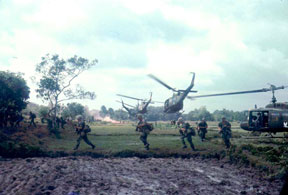Distinguished Flying Cross
 USA / 2011 / English / Color / Blu-ray (SD) / 62 min
USA / 2011 / English / Color / Blu-ray (SD) / 62 min
Director, Editing: Travis Wilkerson
Photography: Kelly Parker
Sound: Dave Irish
Music: Butte People’s Orchestra, Unknown Cambodian musicians, Ensemble Anton Webern
Producer, Source: Travis Wilkerson
A man in the twilight of his years who served in a helicopter division in the Vietnam War spiritedly recounts his experiences. Listening to his recollections are his two adult sons, sitting on either side of him. His war stories, told humorously as reckless shenanigans, gradually draw out an uneasiness in the viewer as they unfold within novelistic chapters and a frame composition reminiscent of religious painting. As the film intersperses color footage shot by soldiers on the battlefield and lively pop music that might have been heard at the time, a growing dissonance with the man’s tales reverberates throughout this cinematic adventure. Appearing in the film are the director, his father, and younger brother.
[Director’s Statement] What does one do when one sets out to make a film that is about war, while also being a film against war? All films about war, even those which purport most aggressively to oppose war, suffer from a fundamental limitation—they challenge the masculinity of their viewers and thus function as war propaganda. Take one of the best for example, The Thin Red Line. While at once displaying the “horror” of war (absolute cliché), it also constantly asks one nagging question—would you be brave enough to do that? And there’s really only one way to discover the answer.
Films that set out to challenge warfare must perpetually struggle to discover a new syntax, to create a rupture with existing discourse, especially around issues of masculinity and bravery. Seriously, how many atrocities have been instigated by the word “pussy”?
And so I used a set of tactics to “alienate” the viewer—in the old-fashioned Brechtian sense—as in seeing something familiar as if for the first time. That’s the function of text, music, banality, and especially humor, punctuated by the sudden paroxysm of savagery.
Ironically, the film has been celebrated abroad but still hasn’t screened once in the United States. The most militaristic country in world history (I’m speaking objectively now, not rhetorically), with permanent warfare on multiple fronts, still isn’t ready to discuss its real role in the world—predatory and parasitic—nor are any of its cultural gatekeepers. That will demand an alienation effect far more potent than that contained by any film—the disintegration of the empire itself. Fortunately for the planet, that process is well under way.
 Travis Wilkerson
Travis Wilkerson
A chance meeting in Havana with legendary Cuban film propagandist Santiago Álvarez changed the course of Travis Wilkerson’s life. He now makes films in the tradition of the “third cinema,” wedding politics to form in an indivisible manner. His films have screened at scores of venues and festivals worldwide, including Sundance, Toronto, Rotterdam, Vienna, YIDFF, the FID Marseille, and the Musée du Louvre. In 2010, he was named one of the top 50 avant-garde filmmakers of the decade by the Film Comment critics’ poll. His best-known work is an agit-prop essay on the lynching of Wobbly Frank Little called An Injury to One (2002). His other films include Accelerated Development—In the Idiom of Santiago Álvarez (1999; YIDFF 1999), National Archive, V.1 (2001), and Who Killed Cock Robin? (2005). |
